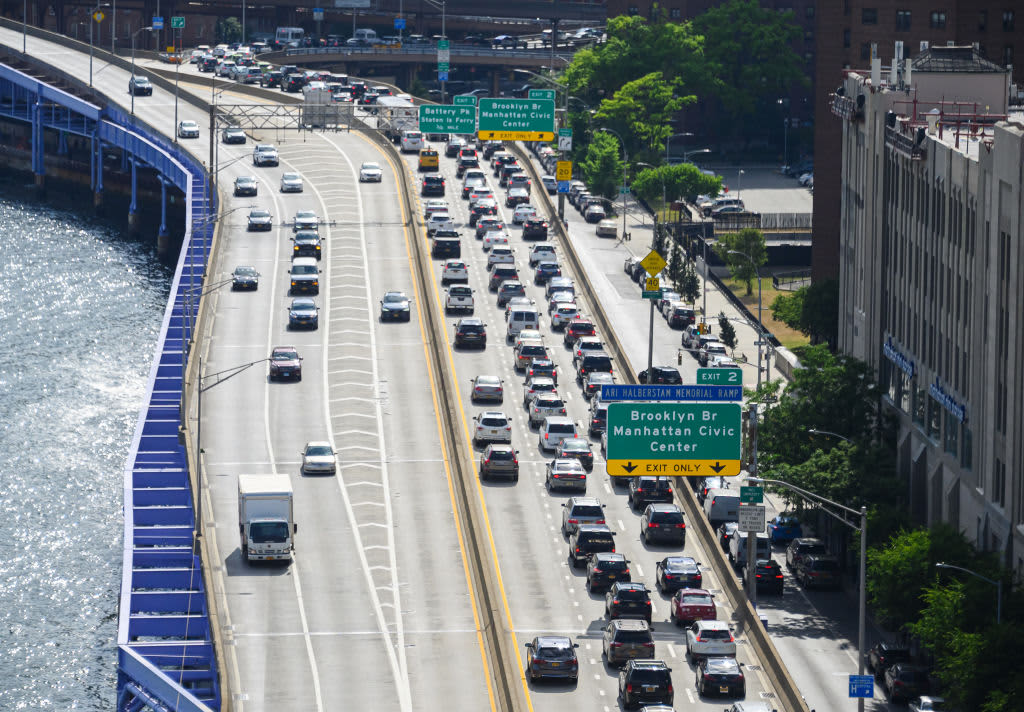
A view of traffic at rush hour on FDR Drive as New York City moves into Phase 2 of re-opening following restrictions imposed to curb the coronavirus pandemic on June 25, 2020.
Noam Galai | Getty Images
As coronavirus cases surge across the United States, data from navigation app Apple Maps shows a slowdown in requests for driving directions, a potential warning sign as the country works to restart the economy amid the pandemic.
The data from Apple tracks the change in volume of directions requests compared with a baseline level on Jan. 13, 2020, before the Covid-19 outbreak made its way around the globe. After a sharp decline in March, requests for driving, walking and transit directions had been steadily increasing in the U.S. But after reaching a peak in early July, driving direction requests have dropped by 6% over the past few days, based on the change in a seven-day moving average.
Notably, the time period for this recent slide includes the Fourth of July, when many Americans typically hit the road for a vacation or to attend a family barbecue.
In a note to clients Tuesday, the RBC cited a "slowing degree of traffic activity" and lower-than-average gasoline prices during the holiday weekend, which it called the busiest driving weekend of the year. "Nationwide, gasoline pricing held steady at $2.18/gal, which is the cheapest for Independence Day weekend in at least a decade and 28% below seasonally normal prices," wrote Michael Tran, an RBC commodity strategist.
Of course, this was not a typical Fourth of July weekend. With coronavirus case counts on the rise nationwide, parades and fireworks events were canceled and officials discouraged people from having gatherings. And many states have put plans to reopen local economies on hold, with governors in Arizona, Florida and Texas taking measures such as closing bars and reducing indoor dining in an effort to slow the spread of the virus.
The downward trend in directions requests is particularly pronounced in states with significant coronavirus outbreaks. The four states that are the leaders in average daily new reported cases over the past week, according to Johns Hopkins University data — Florida, Texas, California and Arizona — have each seen a recent decline back toward the January baseline.
RBC also noted that California, Texas and Florida are the top three gasoline-consuming states.
Not all states have experienced a decline. In states such as Vermont, Maine and Rhode Island, where the number of new infections is low, the trend of increasing movement has not reversed.
While the Apple mobility data is just one signal that may provide insight into what the future will bring for the U.S. economic comeback, it's an example of the kind of "high-frequency" indicators some investors are keeping an eye on. Economic data reports typically lag by a month or so, and may not capture the most recent developments caused by the fast-moving virus. June's jobs report, for example, showed promising employment gains but did not account for the recent resurgence in coronavirus cases due to the timing of the government survey.
Subscribe to CNBC PRO for exclusive insights and analysis, and live business day programming from around the world.
"again" - Google News
July 08, 2020 at 10:59PM
https://ift.tt/2ZeRjId
Apple Maps driving activity is slowing again in warning sign for the economy - CNBC
"again" - Google News
https://ift.tt/2YsuQr6
https://ift.tt/2KUD1V2
Bagikan Berita Ini














0 Response to "Apple Maps driving activity is slowing again in warning sign for the economy - CNBC"
Post a Comment